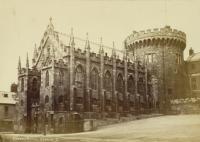The pike in 1916:the failed assault on Dublin Castle
Published in 20th-century / Contemporary History, Features, Issue 6 (Nov/Dec 2012), Revolutionary Period 1912-23, Volume 20
Dublin Castle and one of the pikes inscribed ‘left behind by rebels in No.5 Upper Castle Yard 1916, Dublin’. (National Museum of Ireland)
On Easter Monday, 24 April 1916, a small group of Irish Citizen Army soldiers under Captain Seán Connolly (no relation to James Connolly) attacked the centre of British administration in Ireland—Dublin Castle. At the time it was largely in the hands of civil servants, and sections of it had been handed over to a Red Cross hospital for 67 war-wounded soldiers. The insurgents, despite being few and poorly armed, succeeded in taking the guardroom but failed to take control of the castle, leaving this pike behind when they retreated.
This small attack is one of the many ‘what ifs’ of the 1916 Rising. If a larger and better-equipped force had attacked the castle, it could have proved a better base for the rebels and would have been more easily defended than many of the buildings that they chose. Unbeknownst to the ICA, there were only 25 soldiers in the castle at the time. The first response of the British authorities was to order the 10th Battalion of the Royal Dublin Fusiliers from Royal Barracks (now Collins Barracks) and the 3rd Battalion of the Royal Irish Regiment from Portobello Barracks (now Cathal Brugha Barracks) to move to Dublin Castle as quickly as possible, which they did.
Seán Connolly was forced to retreat with his 30 men and women to nearby City Hall. There he was besieged by over 200 soldiers, who attacked with machine-guns and forced the ICA soldiers onto the roof, where they surrendered on Tuesday 25 April. Connolly was killed early in the battle, along with Lt. Seán O’Reilly, G. Geoghegan and Louis Byrne (all Irish Citizen Army).
This pike represents the reality for nationalists throughout the period from 1912 to 1922—the lack of modern weapons. During the nineteenth century the pike had become the definitive symbol of Irish revolt, especially after the 1798 Rebellion, and it was recommended in 1914 that Irish Volunteers who could not afford to buy or procure a rifle should use a pike as a substitute. Pikes were carried by Volunteers at the funeral of O’Donovan Rossa in 1915 and in parades in Dublin on St Patrick’s Day in 1916. HI
Lar Joye is curator of military history at the National Museum of Ireland (Decorative Arts and History).
















